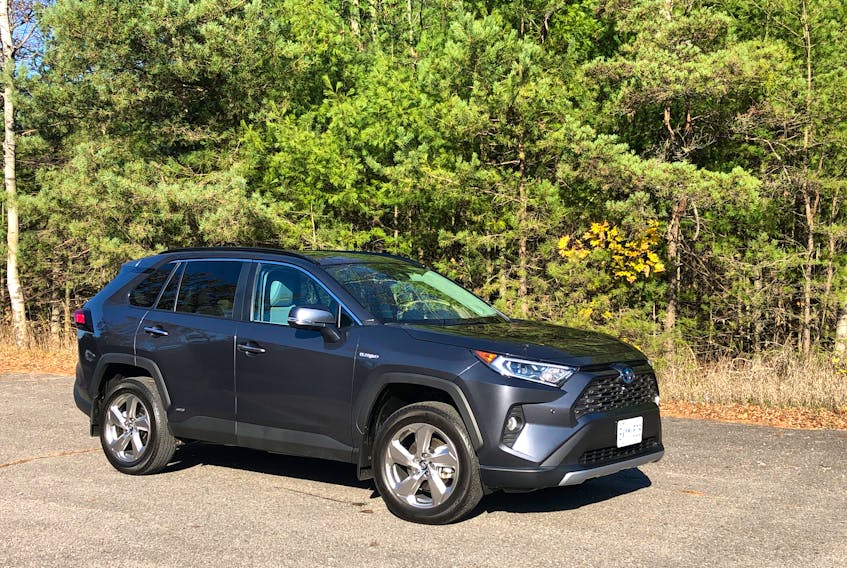Toyota has written the book on hybrid technology. Visit any major city in North America and you are likely to find hybrid Toyotas making up most, if not all of the taxi fleets. Taxi companies and drivers have a vested interest in vehicles that provide trouble-free operation and long life — really long life.
Toyota is universally recognized for the quality and long-term reliability of its products. The same holds true for the hybrid versions. Early worries about the life, reliability, replacement cost, etc. of a hybrid battery have been put to rest. Just ask the taxi fleets.
To put the nail in that coffin, the company recently announced it was extending the warranty on hybrid batteries and related components from eight years or 160,000 km to 10 years/240,000 km.
With all that in mind, let’s take a look at the 2020 Toyota RAV4 Hybrid. Completely redesigned for 2019, it rests on a new platform and has a longer wheelbase, resulting in more interior room. The test vehicle came in top-line Limited trim. At $42,900, it is only $1,610 more than the normal RAV4. Toyota has closed the price gap between hybrid and non-hybrid vehicles to the point where it takes less than three years to recover the added cost of the hybrid.
Fuel economy ratings
Natural Resources Canada rates the 2020 RAV4 AWD gasoline version at 9.2 litres/100 km in the city and 7.1 highway. It lists a combined rating of 8.2 and gives the hybrid version of the RAV4 ratings of 5.7/6.3 and 6.0. Natural Resources says the gas version will cost $2,132 to feed with gas if driven 20,000 km over a mix of city and highway driving per year. The hybrid model — $1,560.
A closer look at those numbers reveals the biggest advantage for the hybrid lies in city driving — thus the popularity with taxi fleets. If most of your driving is in the city, you can expect payback much more quickly.
In the meantime, in addition to less frequent trips to the gas pumps, you’ll have more power and performance with the hybrid. You will also get an extremely well-built compact crossover laced with features and functions, especially those on the safety front.
More power

With the addition of power from the electric motor, the hybrid becomes the most powerful RAV4 since 2012 when a V6 engine was available. The instant torque of the electric motor is felt immediately upon pressing the accelerator motor. Should sustained wide-open throttle be called for, it will be accompanied by a rather loud drone from beneath the hood as the continuously variable transmission keeps the engine in its sweet spot.
Under normal driving conditions, the RAV4 hybrid feels and drives like a conventional ute. I am not a fan of these transmissions, but it is hard to argue with the fuel efficiency and performance of the RAV4 hybrid. My wife, who more closely resembles the average driver/consumer, would not know this is a hybrid unless she noticed the chrome badge on the hatch or front fenders.
Strong case for hybrids
The best-selling Toyota in the country was completely redesigned for the 2019 model year. Built on a new platform, it boasts more interior space than the first generation. The only changes for 2020 are more sound insulation beneath the hood and the addition of Android Auto smartphone functionality and Toyota Connected Service to the standard equipment list.
The fifth-generation RAV4 makes a compelling case for hybrids. The new, smaller and lighter battery sits under the second row of seats in space made possible by the new platform’s longer wheelbase and wider track. As a result, cargo space is identical to the non-hybrid RAV4. A new pricing structure brings payback for the hybrid’s extra cost to a couple of years. In the meantime, operating costs are lower and performance greater.
It is no wonder that more than 20 per cent of RAV4s sold in Canada are hybrids. That number will be even higher as battery supply starts to catch up to demand.
I can’t believe I am saying this, but I actually prefer the hybrid version of the 2020 Toyota RAV4.
The specs
Model: 2020 Toyota RAV4 Hybrid Limited
Engine: 2.5-litre, four-cylinder gasoline engine (176-hp, 163 lb.-ft.) coupled with electric motor (149-hp, 88 lb.-ft.), 219 net horsepower, 206 net lb.-ft. of torque, regular fuel
Driveline: continuously variable automatic transmission, all-wheel drive
NRCan rating (litres/100km city/highway): 5.8 / 6.3
Length: 4,595 mm
Width: 1,855 mm
Wheelbase: 2,690 mm
Weight: 1,950 kg
Price: $42,900 base, $44,036 as tested, including freight
Standard equipment: heated steering wheel, dual zone automatic climate control, Entune Premium audio (embedded traffic, weather, automatic collision notification, stolen vehicle locator, navigation, 20-cm screen), 11-speaker JBL audio system with Remote (includes embedded navigation and Destination Assist), heated and ventilated front seats, heated rear seats, a driver’s seat memory system, digital display rear view mirror, 18” alloy wheels, wireless charging system, and a “kick sensor” power back door.
Options on test vehicle: none









